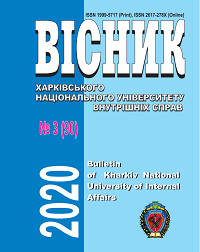Supervision and Control as Special Forms of Protecting Labor Rights of Employees who Work for Employers Being Individuals
DOI:
https://doi.org/10.32631/v.2020.3.06Keywords:
supervision, control, form, protection, labor rights, an employee, an employer being an individual.Abstract
The emphasis has been placed on the fact that the number of recent cases of violation of labor rights of employees working for employers being individuals has significantly increased, which, in turn, necessitates effective supervision and control in this area. Based on the analysis of scientific views, the author has provided own definition of supervision and control as special forms of protecting labor rights of employees working for employers being individuals. It has been emphasized that the control within the framework of the considered issues ensures observance of the law in the sphere of labor, allows to reveal and eliminate certain shortcomings in time, as well as to take measures to prosecute employers who have violated current labor legislation. Features of this scientific category have been outlined. It has been stated that the control and supervision activity acts as a kind of guarantee of the realization of the right of employees to fair and safe working conditions, proper equipment of workplaces and compliance with the law by employers while concluding an employment contract with an employee. It has been argued that the implementation of control and supervisory activities in the studied area relies on various public authorities, where their main functions should include the detection of violations of labor rights of employees by employers, development of propositions to prevent violations of labor laws, monitoring the compliance with regulations issued in regard to employer in the result of inspections by the competent authorities, development and approval of the annual plan for scheduled inspections; drawing up minutes on administrative offenses against employers who have violated labor legislation; organization and monitoring of the compliance with labor legislation, including the collection, processing and analysis of information, operation of an automated information system for control and supervision.
Downloads
References
Busel V.T. (compositor and chief ed.), 2009. Great Explanatory Dictionary of Modern Ukrainian Language [Velykyi tlumachnyi slovnyk suchasnoi ukrainskoyi movy]. Kyiv; Irpin: Perun.
Syrotiak M.R., 2007. Protection of the rights of the victim in proceedings on administrative offenses [Zakhyst prav poterpiloho v provadzhenni v spravakh pro administratyvni pravoporushennia]. Ph.D. dissertation. Yaroslav Mudryi National Law Academy.
Yakovleva A.V., 2007. Ways to protect employees (conceptual aspect) [Sposoby zashchity trudovykh prav rabotnikov (kontseptual'nyi aspekt)]. Abstract of Ph.D. dissertation. Moscow State Law University.
Kobrynskyi V.Yu., 2006. Administrative and legal aspects of defining the concept of control [Administratyvno-pravovi aspekty vyznachennia poniattia kontroliu]. Ûridična Ukraïna – Legal Ukraine, No. 12, pp. 45-48.
Bytiak Yu.P., Harashchuk V.M. and Zui V.V. (eds), 2010. Administrative law [Administratyvne pravo]. Kharkiv: Pravo.
Cherkes M. and Vasyliev S., 1991. On Constitutional Court of Ukrainian SSR [Pro Konstytutsiinyi Sud URSR]. Radianske pravo, No. 4, pp. 3-8.
Nesterova T.A., 2005. Protection of labor rights in Russia: legal essence and priority role of government agencies [Zashchita trudovykh prav v Rossii: yuridicheskaya sushchnost' i prioritetnaya rol' gosudarstvennykh organov]. D.Sc. dissertation. Perm State University.



